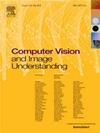MF-LPR2:基于光流的多帧车牌图像恢复与识别
IF 4.3
3区 计算机科学
Q2 COMPUTER SCIENCE, ARTIFICIAL INTELLIGENCE
引用次数: 0
摘要
车牌识别(LPR)在交通执法、犯罪调查和监控中具有重要意义。然而,行车摄像头图像中的车牌区域通常存在低分辨率、运动模糊和眩光等问题,这给准确识别带来了挑战。现有的依赖于预训练先验的生成模型不能可靠地恢复这种低质量的图像,经常会引入严重的伪影和扭曲。为了解决这个问题,我们提出了一种新的多帧车牌恢复和识别框架MF-LPR2,它通过对齐和聚合相邻帧来解决低质量图像中的模糊性,而不是依赖于预训练的知识。为了实现精确的帧对齐,我们采用了最先进的光流估计器,结合精心设计的算法,通过利用车牌图像序列固有的时空一致性来检测和纠正错误的光流估计。我们的方法提高了图像质量和识别精度,同时保留了输入图像的证据内容。此外,我们构建了一个新的现实LPR (RLPR)数据集来评估MF-LPR2。RLPR数据集包含200对低质量车牌图像序列和高质量伪真地图像,反映了现实场景的复杂性。在实验中,MF-LPR2在PSNR、SSIM和LPIPS方面明显优于8种最新的恢复模型。在识别方面,MF-LPR2的准确率为86.44%,优于11个基线模型中最佳的单帧LPR(16.18%)和多帧LPR(82.55%)。烧蚀研究的结果证实,我们的滤波和细化算法显著有助于这些改进。本文章由计算机程序翻译,如有差异,请以英文原文为准。
MF-LPR2: Multi-frame license plate image restoration and recognition using optical flow
License plate recognition (LPR) is important for traffic law enforcement, crime investigation, and surveillance. However, license plate areas in dash cam images often suffer from low resolution, motion blur, and glare, which make accurate recognition challenging. Existing generative models that rely on pretrained priors cannot reliably restore such poor quality images, frequently introducing severe artifacts and distortions. To address this issue, we propose a novel multi-frame license plate restoration and recognition framework, MF-LPR, which addresses ambiguities in poor quality images by aligning and aggregating neighboring frames instead of relying on pretrained knowledge. To achieve accurate frame alignment, we employ a state-of-the-art optical flow estimator in conjunction with carefully designed algorithms that detect and correct erroneous optical flow estimations by leveraging the spatio-temporal consistency inherent in license plate image sequences. Our approach enhances both image quality and recognition accuracy while preserving the evidential content of the input images. In addition, we constructed a novel Realistic LPR (RLPR) dataset to evaluate MF-LPR. The RLPR dataset contains 200 pairs of low-quality license plate image sequences and high-quality pseudo ground-truth images, reflecting the complexities of real-world scenarios. In experiments, MF-LPR outperformed eight recent restoration models in terms of PSNR, SSIM, and LPIPS by significant margins. In recognition, MF-LPR achieved an accuracy of 86.44%, outperforming both the best single-frame LPR (16.18%) and the multi-frame LPR (82.55%) among the eleven baseline models. The results of ablation studies confirm that our filtering and refinement algorithms significantly contribute to these improvements.
求助全文
通过发布文献求助,成功后即可免费获取论文全文。
去求助
来源期刊

Computer Vision and Image Understanding
工程技术-工程:电子与电气
CiteScore
7.80
自引率
4.40%
发文量
112
审稿时长
79 days
期刊介绍:
The central focus of this journal is the computer analysis of pictorial information. Computer Vision and Image Understanding publishes papers covering all aspects of image analysis from the low-level, iconic processes of early vision to the high-level, symbolic processes of recognition and interpretation. A wide range of topics in the image understanding area is covered, including papers offering insights that differ from predominant views.
Research Areas Include:
• Theory
• Early vision
• Data structures and representations
• Shape
• Range
• Motion
• Matching and recognition
• Architecture and languages
• Vision systems
 求助内容:
求助内容: 应助结果提醒方式:
应助结果提醒方式:


